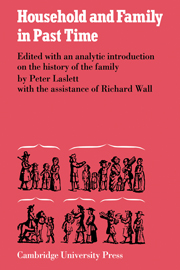Book contents
- Frontmatter
- Contents
- List of contributors
- Preface to the first impression
- Preface to the second impression
- 1 Introduction: The history of the family
- 2 Some demographic determinants of average household size: An analytic approach
- 3 The evolution of the family
- ENGLAND
- WESTERN EUROPE
- SERBIA
- JAPAN
- NORTH AMERICA
- 20 The average size of families and households in the Province of Massachusetts in 1764 and in the United States in 1790: an overview
- 21 Demography and psychology in the historical study of family-life: a personal report
- 22 Rhode Island family structure: 1875 and 1960
- Bibliography
- Index
21 - Demography and psychology in the historical study of family-life: a personal report
Published online by Cambridge University Press: 02 November 2009
- Frontmatter
- Contents
- List of contributors
- Preface to the first impression
- Preface to the second impression
- 1 Introduction: The history of the family
- 2 Some demographic determinants of average household size: An analytic approach
- 3 The evolution of the family
- ENGLAND
- WESTERN EUROPE
- SERBIA
- JAPAN
- NORTH AMERICA
- 20 The average size of families and households in the Province of Massachusetts in 1764 and in the United States in 1790: an overview
- 21 Demography and psychology in the historical study of family-life: a personal report
- 22 Rhode Island family structure: 1875 and 1960
- Bibliography
- Index
Summary
In the whole, gathering effort to promote the historical study of family-life, one approach – an essentially ‘quantitative’ or ‘demographic’ approach – seems to have largely predominated. Perhaps this is fitting, since some of the most immediate and elementary questions about the family do indeed present a quantitative aspect. In this chapter, I propose now to examine the relation between the demographic or quantitative approach and what I would call a psychological one. What I have to offer is quite fragmentary – no more than a tentative and incomplete sampling of some work currently in progress. Hence my rather informal style of presentation, and the purposely cautious subtitle, ‘A Personal Report.’
When I first came to the study of family-life, and more specifically family-life in colonial America, the question of household size and membership was an open one. The notion that maybe there were quite a few ‘extended’ households around still seemed to have some life in it, particularly with reference to the seventeenth century, the period of settlement as such and immediately thereafter. My work on Plymouth Colony was initially directed right to this point; and I might add that Professor Greven was doing very much the same thing with his materials on Andover in the Massachusetts Bay Colony. Our findings, it seems to me, were really very similar – though we have managed to keep arguing about their meaning ever since.
- Type
- Chapter
- Information
- Household and Family in Past Times , pp. 561 - 570Publisher: Cambridge University PressPrint publication year: 1972
- 2
- Cited by

